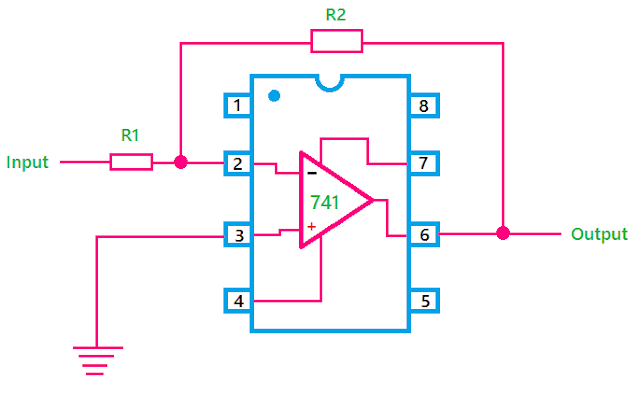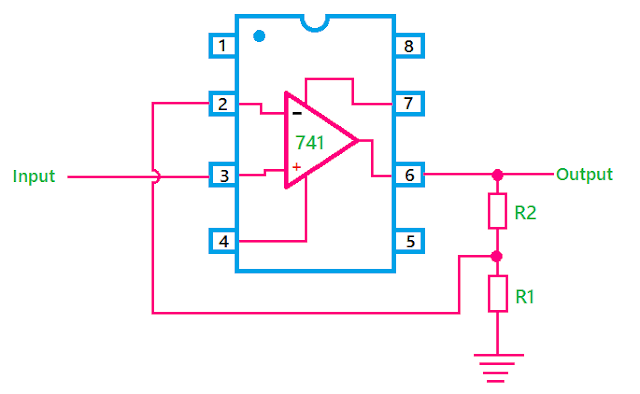[Op Amp] Circuit diagram, Types and Applications - Operational Amplifier
Operational Amplifier[Op Amp]
Operational Amplifier or Op Amp is basically an Amplifier with very high gain which amplifies the electronic signals. But there is a little difference between a general Amplifier and Operational Amplifier or Op Amp. An Op-Amp is nothing but an analog electronic circuit. The Op Amp has many transistors inside it. We can connect external passive elements like resistors, capacitors, etc to use them for different purposes. We will discuss all the Op-Amp circuits, types, and applications.
Why it is called Operational Amplifier?
In earlier days when digital computers and calculators are not available these types of amplifiers are used for mathematical operations like addition, substruction, integration, differentiation, etc that is why these types of amplifiers are called Operational Amplifiers or Op Amp. In modern days calculators and computers etc do mathematical operations in digital forms but the Op Amp performs the mathematical operations in analog forms.
By connecting the external resistors and capacitors with these amplifiers we can perform the mathematical operations.
Op Amp Symbol:
Construction of Op-Amp:
If you see the symbol of Op Amp then you will see that the Op Amp has two inputs and one output. The two inputs of the operational amplifier are called the Non-Inverting terminal and Inverting terminal. The Non-Inverting terminal is indicated by the 'plus(+)' sign and the Inverting terminal is indicated by the 'minus(-)' sign. The Op Amp also has two terminals for Power Supply.
Working of Op-Amp:
The working principle of the Op Amp is very simple. As it has two input terminals so we can apply two input signals together. When we apply the two input signals, at first, the Op Amp creates the difference between the two signals and then it amplifies.
For example, we applied two signals V1 and V2. We assumed the gain of the amplifier is A. When there is no feedback path from the output to the input of the Op Amp then the A is called open loop gain. Now we considering open loop gain. So the output will be Vout = A(V1-V2)
Suppose we applied one input signal to the Non-Inverting terminal and the Inverting terminal is grounded. In this case, the output will be
Vout = A(V1-V2) = A(V1-0) = A*V1
From this equation, we can also say the amplified output signal is in the same phase as the input signal.
Now if we applied the input signal to the Inverting terminal and the Non-Inverting is grounded then the output signal will be
Vout = A(V1-V2) = A(0-V2) = A*-V2 = -AV2
From this equation, we can say the amplified output signal has a 180-degree phase with respect to the input signal.
As when we applied the input signal to that terminal the output signal is inverted that is why it is called Inverting terminal.
Now suppose we applied the input voltage Vin to the Non-Inverting terminal with respect to the Inverting terminal then the output will be
Vout = A*Vin
The equivalent circuit of Op-Amp:
In the equivalent circuit of the Op-Amp two resistor are shown one is input resistance which is a very high-value resistor and another is output resistor which is a very low-value resistor.
The characteristics of OP Amp:
(1) The open loop gain of Op-Amp: An ideal Op-Amp should have infinite open loop gain. But practically an Op-Amp has an open loop gain of 1000000 to 10000000. That means if we applied a 1 mV input signal to the Op-Amp the output signal will be 1mV*1000000=100V.
(2) Input Impedance: The ideal Op Amp should have an infinite input impedance which means when we apply an input signal to the Op-Amp it should not be drawn any current or should not flow any leakage current.
(3) Output Impedance: The output impedance of an operational amplifier (op amp) represents the impedance that the op-amp presents to the load connected to its output. An ideal Op-Amp should have zero output impedance.
(4) Frequency Range: An ideal Op-Amp should have an infinite frequency range which means it should operate at any frequency from very low frequency to very high frequency.
(5) Slew Rate: The ideal Op-Amp should have an infinite slew rate. The slew rate of an operational amplifier (op amp) refers to the maximum rate of change of its output voltage. It is typically specified in volts per microsecond (V/μs) or volts per millisecond (V/ms).
(6) Common Mode Rejection Ratio(CMMR): The Ideal Op-Amp should have infinite CMMR. The Common Mode Rejection Ratio (CMRR) is a measure of an operational amplifier's ability to reject common-mode signals, which are signals that appear simultaneously on both input terminals of the op-amp with respect to ground.
Voltage Transfer Curve of Op-Amp:
Let's explain the voltage transfer curve of the Op-Amp. The 'X' axis of the curve represents the differential input of the Op-amp which means it indicates the difference between the two input signals(Inverting and Non-Inverting). The 'Y' axis of the curve represents the output signal or output voltage of the Op-Amp. The gain of the Op-Amp is shown in the figure.
The voltage transfer curve of the Op-Amp indicates that the Op-Amp can amplify the input signal up to a certain value, then it will be saturated and the output will not be increased even if the input is increased. The saturated voltage of the Op-Amp depends upon the positive biasing voltage. The saturated voltage of the Op-Amp is always less than the positive biasing voltage.
Block Diagram of Op-Amp IC:
The operational amplifier comes in the form of an IC. The IC no. of Op-Amp is 741. The internal block diagram of IC 741
IC 741 is an 8-pin Op-Amp IC. The 8 pins are,
Pin 1: Offset Null
Pin 2: Inverting terminal for giving input signal.
Pin 3: Non-Inverting terminal for giving input signal.
Pin 4: Ground terminal to provide power supply or biasing to the Op-Amp
Pin 5: Offset Null
Pin 6: Output pin to connect the load and feedback path.
Pin 7: Vcc or Positive pin to provide the power supply.
Pin 8: Not connected to the internal circuit.
The different Op-amp ICs has different specification. The characteristics of an Op-Amp IC is represented by the IC's specification. Let's look at the specification of the IC741,
Parameters | Value |
Input Impedance | 2 M Ω |
Output Impedance | 75 Ω |
Open-Loop Gain | 1000000 |
Offset Voltage | 1 mV |
Slew Rate | 0.5 V/ μS |
CMMR | 70-90dB |
Applications of Op-Amp:
There are many useful applications of Op-Amp. Some applications of Op-Amp are given below,
1. A very important application of the Op-Amp is amplification. The Op-Amp is used as Inverting amplifier, Non-Inverting amplifier.
2. The Op-Amp is used as a Voltage Follower.
3. The Op-Amp is used as Comparator.
4. The Op-Amps are sometimes used as an audio preamplifier which was used before the power amplifier in the audio system.
5. The Operational amplifier is also used as Active Filter.
6. The other important application of an operational amplifier is Oscillator. The Op-Amp can produce the oscillating signal of any desired frequency and waveforms.
7. The operational amplifiers are used for converting waveforms which means we can convert a sine wave into a square wave using an Op-Amp.
8. By using an operational amplifier we can convert the analog signal into a digital signal.
9. The conversion of the digital signal into an analog signal also be possible by the Op-Amp.
Circuit diagram of Op-Amp as Inverting Amplifier:
As you see in the above circuit diagram the input is connected through a resistor R1 to the Inverting terminal. The non-inverting terminal is grounded. The inverting terminal is also connected to the output terminal through a resistor R2. We know that the gain of Op-Amp is generally very high so to reduce the gain and keep it to our desired value we use the Feedback Path.
So always keep in mind that the feedback path is used to reduce the gain of the Op-Amp.
In this case, the closed-loop gain of the Op-Amp will be A = R2/R1
Circuit diagram of Op-Amp as Non-Inverting Amplifier:
As you see in the above circuit diagram the non-inverting terminal is used as Input and the inverting terminal is connected between the R1 and R2 resistors. The output signal will be in the same phase as the input signal.
In this case, the gain of the Op-Amp will be A = 1+(R2/R1)
Circuit diagram of the operational amplifier as a Voltage Follower:
The circuit diagram of the voltage follower is very simple. The inverting terminal is directly connected to the output terminal. The voltage follower circuit has very high input impedance and very low output impedance.
Read Also:
- [BEST] Applications, Advantages, Disadvantages of Differential Amplifier
- [Actual] Difference Between Power Amplifier and Voltage Amplifier
- [Actual] Difference between Analog and Digital Signal with Examples
- Coupling in Amplifier, Types, Application, Advantages
- Actual Difference Between Oscillator and Amplifier
- Ideal Op Amp Characteristics | Operational Amplifier
Thank you for visiting the website. Keep visiting for more updates.











